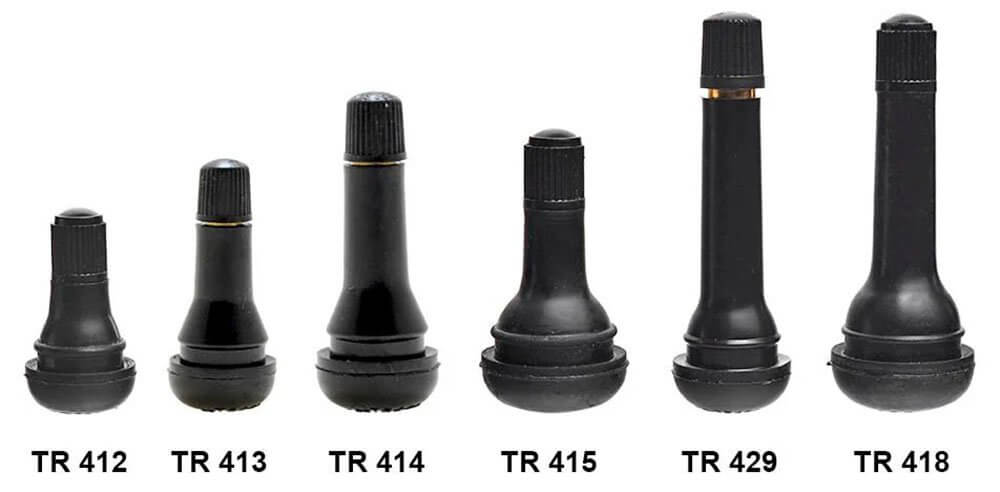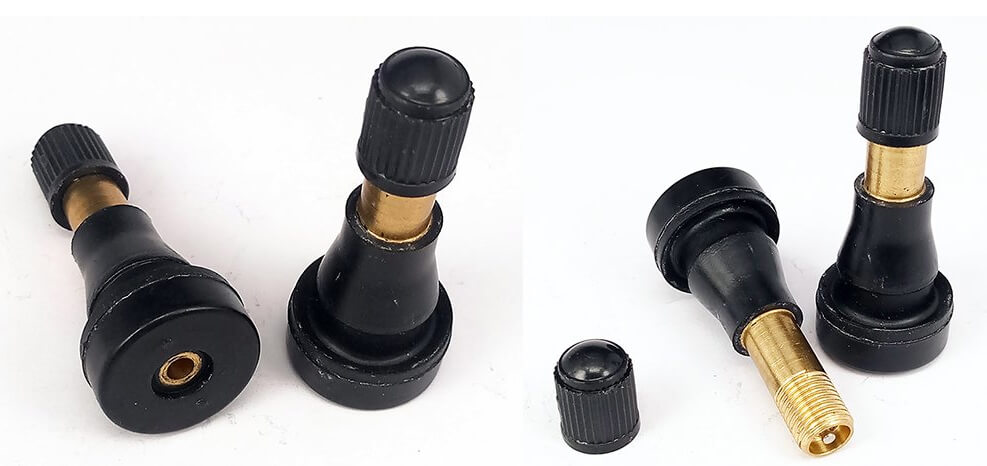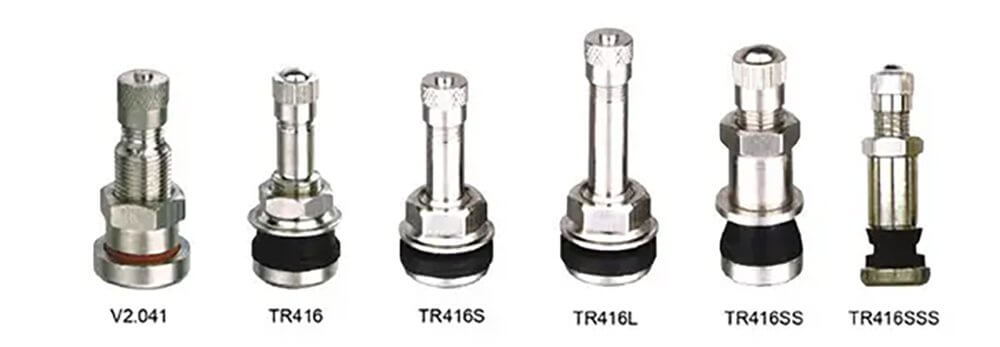Description of tubeless tyre valve stem and its components
What is a tyre valve stem?
A tyre valve stem is a small tube system that is used to inflate a tire. The system is basically a one-way door that is used to transfer gas (in this case, air pressure) into the air chamber (tire). There are different types of valves available.
What is a tyre valve stem used for?
A valve is found on most pneumatic tires, from car to bicycle models. A tire valve is used to increase or decrease the air pressure inside the tire. Once the air pressure is in the tire, the tire valve does not let the air pressure escape on its own.
A tire stem helps the tire maintain the optimal pressure level by using its different components. A valve consists of a valve stem body, a valve core, and a valve stem cap. They work together to keep the pressure level inside the tire correct.
The various components of a valve work together to ensure the safe performance of the tire. If the valve is damaged, a loss of air pressure may occur. However, as long as they are working properly, the valve will hold air and guarantee the performance of the tire
Different types of tyre valve stem
There are many types of tire valves available for purchase. The type you need depends largely on the various components: mainly what type of tire the valve is used for.
There are three types of tire valve stems manufactured:
- Tubeless Rubber Snap-in Tire Valve
- Tubeless Snap-in High-Pressure Tire Valve
- High-Pressure Metal Snap-in Tire Valve
These have various applications! Let's discuss them in more detail.
Tubeless Rubber Snap-in Tire Valve

The most common type of valve is probably the tubeless rubber snap-on tire valve, as they are used on passenger cars, light trailers, and various light trucks. They are also used for off-road racing.
These tire valves have a maximum cold tire inflation pressure of 65 psi. The valve stem size is usually between 0.7 inches and 2.5 inches, and can fit rim holes with a diameter of 0.453 inches or 0.625 inches. They usually come with plastic valve stem caps, but some can be purchased with chrome sleeves or metal tire pressure caps. However, this is for cosmetic purposes only.
Check out this valve stem size chart:
| Industry Valve Number | Max Inflation Pressure [Psl] | Effec tive Length [inch] | Hole Diametar in Wheel [inch] |
| 412 | 65 | 0.88 | 0.453 |
| 413 | 65 | 1.25 | 0.453 |
| 414 | 65 | 1.50 | 0.453 |
| 415 | 65 | 1.75 | 0.453 |
| 418 | 65 | 2.00 | 0.453 |
| 423 | 65 | 2.50 | 0.453 |
| 425 | 65 | 2.00 | 0.625 |
Tubeless Snap-in High-Pressure Tire Valve

Tubeless snap-on high-pressure tire valves function the same as the previous type. However, they are used in applications where the maximum pressure is higher than 65 psi. In other words, they are suitable for medium to heavy-duty trucks and trailers that use pressure to handle a larger weight.
These tire valves are available in two rim hole fitments: 0.453-inch for tires with a maximum cold inflation pressure of 80 psi, and 0.625-inch for tires with 100 psi. Due to vehicle applications, these valve stem sizes range from 1.25 inches to 2 inches. High-pressure valve stems are designed for steel wheels. They come with a thick rubber snap-on base, a metal barrel, and a plastic pressure cap.
High-pressure tubeless snap-on valve size chart:
| Industry Valve Number | Max Inflation Pressure [Psl] | Effec tive Length [inch] | Hole Diametar in Wheel [inch] |
| 600HP | 80 | 1.27 | 0.453 |
| 602HP | 80 | 2.00 | 0.453 |
| 801HP | 100 | 1.31 | 0.625 |
| 802HP | 100 | 2.00 | 0.625 |
High-Pressure Metal Clamp-in Tire Valve

High-pressure metal clamp-in tire valve stems are clamp-on models that use a rubber washer that seals the valve to the wheel when you tighten the retaining nut. These valves are often used in dragsters or vehicles that go over 130 mph.
Most metal clamp-on tire valves are suitable for 0.453-inch and 0.625-inch rim holes. However, some special applications are available for 0.236-inch and 0.315-inch rim holes. In addition, they are available in straight or curved styles to accommodate even unique wheel shapes. The maximum cold tire inflation pressure for these valves is 200 psi.
These valves are available in two mounting styles: with the retaining nut inside the rim or outside the rim. Many drivers prefer to hide them inside the rim for aesthetic reasons. However, the external mounting allows you to tighten the nut when needed.
Valve Stem Components
We have talked about the types of tire valves you can purchase for different vehicles. Now, let's see their components.
Like most auto parts, valves also consist of multiple parts, which are:
Valve cap: A valve cap should be used on all valve stems. There is a good reason for this! Moisture contamination and loss of air pressure at high speeds can cause problems. They can damage the valve core or cause the tire to do flat. However, a valve cap will help prevent these issues.
Tire valve caps are available to be manufactured from plastic, metal, or metal with a special screwdriver design. When these caps are used greatly depends on which vehicle they are on. When it comes to everyday driving, a plastic tire pressure valve cap should be enough. However, for racecar applications, a metal one is better. Tire stem caps are either knurled or hexagon-shaped to make them easier to remove.
A valve core: A valve core is the main seal inside the stem. This part of the stem seals tire pressure inside the tire, preventing it from escaping. It should be tightly screwed into the valve core chamber. They are manufactured with shorter (for high speed applications) and longer lengths, and nickel-plated and brass valve cores are available.
These valve cores basically consist of a spring-loaded pin that is moveable. This allows air pressure to inflate and deflate the tires. This valve stem seal prevents pressurized air from escaping the tires when the caps are off. The valve stem core is durable, but dirt, moisture, and sand can damage it. Dirt and sand will prevent valve cores from sealing properly, while moisture will freeze and damage the valve cores.
Valve extension: If you fit wheel covers on your car, you can use valve extensions to make the inflation process easier. These nylon or metal extenders are available in sizes between 0.5" and 2".
It is important to select the ideal extension length or to purchase durable, preferably metal, ones. Road and weather conditions and driving habits can easily damage these extensions, which will leave to other issues.


